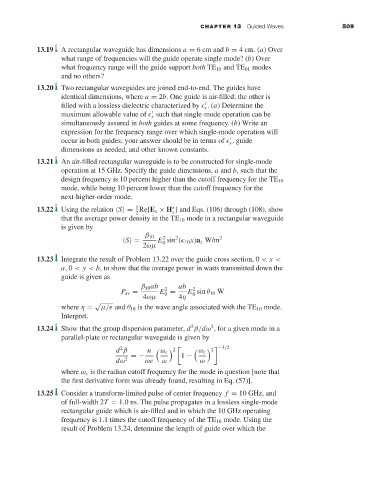Page 527 - Engineering Electromagnetics, 8th Edition
P. 527
CHAPTER 13 Guided Waves 509
13.19 A rectangular waveguide has dimensions a = 6cmand b = 4 cm. (a)Over
what range of frequencies will the guide operate single mode? (b)Over
what frequency range will the guide support both TE 10 and TE 01 modes
and no others?
13.20 Two rectangular waveguides are joined end-to-end. The guides have
identical dimensions, where a = 2b. One guide is air-filled; the other is
filled with a lossless dielectric characterized by .(a) Determine the
r
maximum allowable value of such that single-mode operation can be
r
simultaneously assured in both guides at some frequency. (b) Write an
expression for the frequency range over which single-mode operation will
occur in both guides; your answer should be in terms of , guide
r
dimensions as needed, and other known constants.
13.21 An air-filled rectangular waveguide is to be constructed for single-mode
operation at 15 GHz. Specify the guide dimensions, a and b, such that the
design frequency is 10 percent higher than the cutoff frequency for the TE 10
mode, while being 10 percent lower than the cutoff frequency for the
next-higher-order mode.
1
13.22 Using the relation S = Re{E s × H } and Eqs. (106) through (108), show
∗
s
2
that the average power density in the TE 10 mode in a rectangular waveguide
is given by
β 10 2 2 2
S = E sin (κ 10 x)a z W/m
0
2ωµ
13.23 Integrate the result of Problem 13.22 over the guide cross section, 0 < x <
a, 0 < y < b,to show that the average power in watts transmitted down the
guide is given as
β 10 ab 2 ab 2
P av = E = E sin θ 10 W
0
0
4ωµ 4η
√
where η = µ/ and θ 10 is the wave angle associated with the TE 10 mode.
Interpret.
13.24 Show that the group dispersion parameter, d β/dω , for a given mode in a
2
2
parallel-plate or rectangular waveguide is given by
2
d β n ω c 2 ω c 2 −3/2
dω 2 =− ωc ω 1 − ω
where ω c is the radian cutoff frequency for the mode in question [note that
the first derivative form was already found, resulting in Eq. (57)].
13.25 Consider a transform-limited pulse of center frequency f = 10 GHz, and
of full-width 2T = 1.0 ns. The pulse propagates in a lossless single-mode
rectangular guide which is air-filled and in which the 10 GHz operating
frequency is 1.1 times the cutoff frequency of the TE 10 mode. Using the
result of Problem 13.24, determine the length of guide over which the

